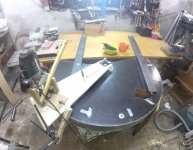Need more info. What kind of grinding? Bench grinder, surface grinder or something else.
Well...that's where it gets complicated. I've built a kind of grinding apparatus on the workpiece.
The workpiece is the black 'semicircle' that is hanging via 2 steel beams. It's carbon/plywood/foam multilayer sandwich with a strip of 2mm SS running bonded to the perimeter (yellow dotted line). The SS strip is 1.5m long, 110mm in height and the runout is 0.6mm

You can see the apparatus that can swivel around a pivot on block bearing while the 'grinding' part is powered with a router. The movement is manual....I mean, by hand literally.

As of now the grinding action is provided by a d.20mm ground shaft, again on block bearings with #40 sandpaper superglued to it. The superglue part actually works just fine but the material removal is painfully slow. To be honest this is a one-off machining so I don't care spending hours to get it done.
The problem is that the action is not 'smooth', at least in the direction where the grinding tends to stall as it's "gearing" into the SS strip if it makes sense.

I image this is not easy to understand and digest - I might need to upload a video n YT and post here the list to give a decent idea.
The original question is related to the fact that I feel that if I could make a tool by piling some 2" or 3" grinding discs -and possibly dressing them on a lathe- I can have a better chance. BTW the shaft position can be finely adjusted and I don;t have much problem in getting it precisely parallel to the machining surface






